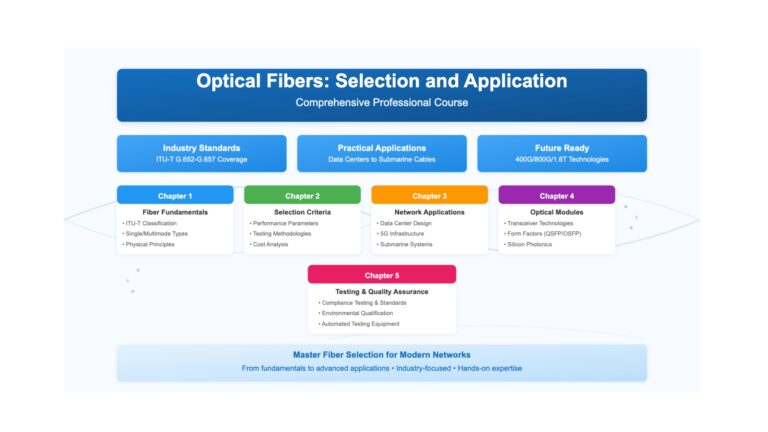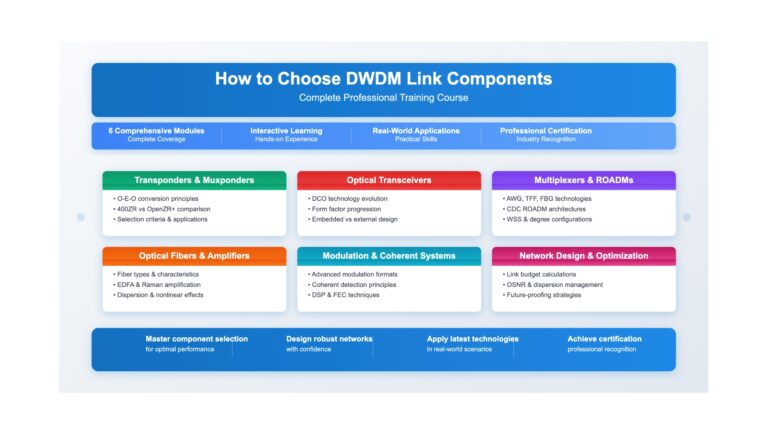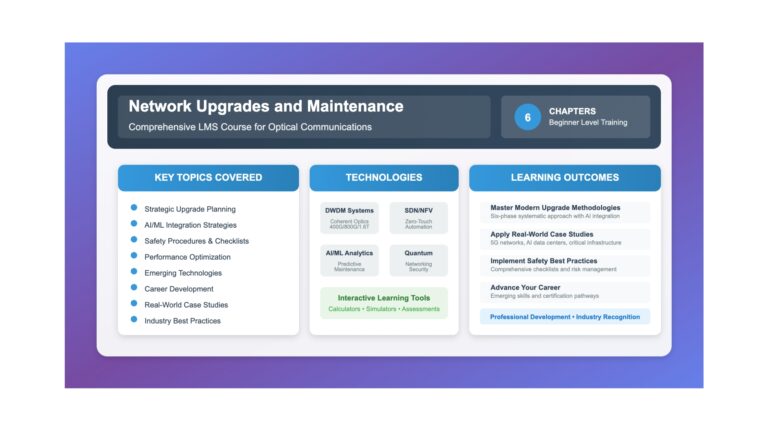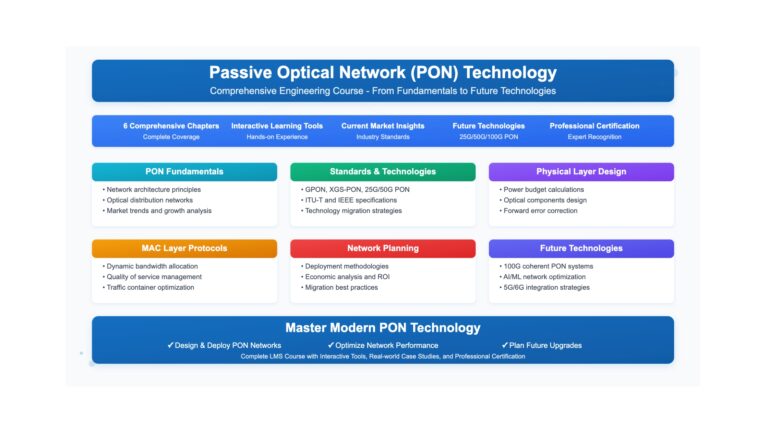Description
Curriculum
Instructor
Learning Objectives
- Understand the fundamental principles of optical communication and light propagation
- Analyze the electromagnetic spectrum and optical window characteristics for fiber transmission
- Compare optical communication advantages over traditional electrical systems
- Calculate basic optical power, attenuation, and link budget parameters
- Evaluate the evolution and current state of optical network technologies in 2025
Curriculum
- 6 Sections
- 61 Lessons
- 10 Weeks
Expand all sectionsCollapse all sections
- Chapter 1: Fundamentals of Optical Communication8
- Chapter 2: Optical Fiber Technology and Characteristics10
- 2.1Introduction and Industry Context
- 2.2Optical Fiber Structure and Light Guidance
- 2.3Numerical Aperture and Light Acceptance
- 2.4Fiber Types and Classifications
- 2.5Fiber Impairments and Limitations
- 2.6Advanced Fiber Technologies and 2025 Developments
- 2.7Fiber Testing and Characterization
- 2.8Case Study: Next-Generation Data Center Interconnect
- 2.9Chapter Summary
- 2.10Self-Assessment Questions
- Chapter 3: Wavelength Division Multiplexing (WDM) Systems11
- 3.1Introduction and Market Context
- 3.2WDM Fundamentals and Operating Principles
- 3.3WDM Components and Subsystems
- 3.4WDM System Design and Performance Analysis
- 3.5Advanced WDM Technologies and 2025 Developments
- 3.6WDM Network Architectures
- 3.7Emerging Applications and Future Trends
- 3.8WDM System Testing and Troubleshooting
- 3.9Future WDM Technologies and Research Directions
- 3.10Chapter Summary
- 3.11Self-Assessment Questions
- Chapter 4: Coherent Optical Transmission Systems10
- 4.1Introduction and Technology Evolution
- 4.2Coherent Detection Principles
- 4.3Digital Signal Processing in Coherent Systems
- 4.4Advanced Modulation Formats
- 4.5Forward Error Correction and Performance Metrics
- 4.62025 Coherent Technology Breakthroughs
- 4.7Coherent System Design and Optimization
- 4.8Future Trends and Research Directions
- 4.9Chapter Summary
- 4.10Self-Assessment Questions
- Chapter 5: Optical Network Architectures and Design10
- 5.1Introduction to Optical Network Design
- 5.2Network Topology Fundamentals
- 5.3Protection and Restoration Mechanisms
- 5.4Routing and Wavelength Assignment (RWA)
- 5.5Software-Defined Optical Networks (SDON)
- 5.6Network Performance Optimization and Analytics
- 5.7Emerging Network Architectures and Trends
- 5.8Network Design Case Study: Global Hyperscale Provider
- 5.9Chapter Summary
- 5.10Self-Assessment Questions
- Chapter 6: Future Trends and Emerging Technologies12
- 6.1The Optical Networking Horizon: 2025 and Beyond
- 6.2Technology Roadmap and Timeline
- 6.3Space Division Multiplexing: The Next Capacity Frontier
- 6.4Quantum Optical Networks
- 6.5Artificial Intelligence and Autonomous Networks
- 6.6Sustainability and Green Optical Networks
- 6.7Space-Based Optical Communications
- 6.8Photonic Computing and In-Network Processing
- 6.9Beyond 2030: Transformative Vision
- 6.10Preparing for the Future: Strategic Recommendations
- 6.11Chapter Summary
- 6.12Self-Assessment Questions
Admin

21 Students36 Courses

Free
1 student
61 lessons
Language: English
0 quiz
Assessments: Yes
Skill level All levels
Courses you might be interested in
Fiber Optics & Components
Learning Objectives Understand the fundamental principles of optical fiber communication and light propagation Classify different types of optical fibers based on ITU-T standards and industry specifications Analyze the key physical...
-
41 Lessons
Free
DWDM Technology
Learning Objectives Understand the fundamental principles of Dense Wavelength Division Multiplexing (DWDM) Analyze the role and functionality of transponders in DWDM networks Compare different transponder types and their applications Evaluate...
-
49 Lessons
Free
Network Automation
Learning Objectives Understand the fundamental principles and drivers of network upgrades in modern optical communications Analyze capacity requirements, technology advancements, and cost-benefit considerations for upgrade decisions Evaluate compatibility, interoperability, and...
-
47 Lessons
Free
Advanced Technologies
Learning Objectives Understand the fundamental concepts and principles of Passive Optical Networks Analyze the evolution of optical access networks from copper to fiber technologies Compare PON architectures with traditional point-to-point...
-
36 Lessons
Free





